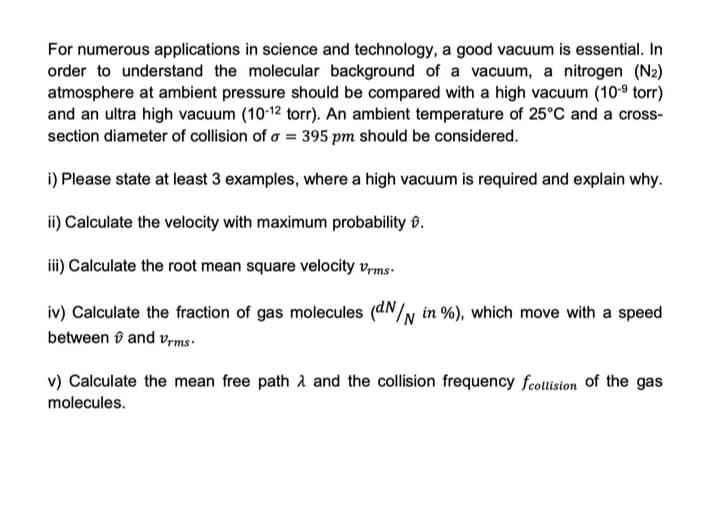For numerous applications in science and technology, a good vacuum is essential. In order to understand the molecular background of a vacuum, a nitrogen (N2) atmosphere at ambient pressure should be compared with a high vacuum (109 torr) and an ultra high vacuum (10-12 torr). An ambient temperature of 25°C and a cross- section diameter of collision of a = 395 pm should be considered. i) Please state at least 3 examples, where a high vacuum is required and explain why. ii) Calculate the velocity with maximum probability p. iii) Calculate the root mean square velocity v-ms· idNI uith
For numerous applications in science and technology, a good vacuum is essential. In order to understand the molecular background of a vacuum, a nitrogen (N2) atmosphere at ambient pressure should be compared with a high vacuum (109 torr) and an ultra high vacuum (10-12 torr). An ambient temperature of 25°C and a cross- section diameter of collision of a = 395 pm should be considered. i) Please state at least 3 examples, where a high vacuum is required and explain why. ii) Calculate the velocity with maximum probability p. iii) Calculate the root mean square velocity v-ms· idNI uith
Introduction to Chemical Engineering Thermodynamics
8th Edition
ISBN:9781259696527
Author:J.M. Smith Termodinamica en ingenieria quimica, Hendrick C Van Ness, Michael Abbott, Mark Swihart
Publisher:J.M. Smith Termodinamica en ingenieria quimica, Hendrick C Van Ness, Michael Abbott, Mark Swihart
Chapter1: Introduction
Section: Chapter Questions
Problem 1.1P
Related questions
Question

Transcribed Image Text:For numerous applications in science and technology, a good vacuum is essential. In
order to understand the molecular background of a vacuum, a nitrogen (N2)
atmosphere at ambient pressure should be compared with a high vacuum (10-9 torr)
and an ultra high vacuum (10-12 torr). An ambient temperature of 25°C and a cross-
section diameter of collision of o = 395 pm should be considered.
i) Please state at least 3 examples, where a high vacuum is required and explain why.
ii) Calculate the velocity with maximum probability £.
iii) Calculate the root mean square velocity v,ms-
iv) Calculate the fraction of gas molecules (dN/N in %), which move with a speed
between 9 and vrms.
v) Calculate the mean free path a and the collision frequency fcotlision of the gas
molecules.
Expert Solution
This question has been solved!
Explore an expertly crafted, step-by-step solution for a thorough understanding of key concepts.
Step by step
Solved in 4 steps

Knowledge Booster
Learn more about
Need a deep-dive on the concept behind this application? Look no further. Learn more about this topic, chemical-engineering and related others by exploring similar questions and additional content below.Recommended textbooks for you

Introduction to Chemical Engineering Thermodynami…
Chemical Engineering
ISBN:
9781259696527
Author:
J.M. Smith Termodinamica en ingenieria quimica, Hendrick C Van Ness, Michael Abbott, Mark Swihart
Publisher:
McGraw-Hill Education

Elementary Principles of Chemical Processes, Bind…
Chemical Engineering
ISBN:
9781118431221
Author:
Richard M. Felder, Ronald W. Rousseau, Lisa G. Bullard
Publisher:
WILEY

Elements of Chemical Reaction Engineering (5th Ed…
Chemical Engineering
ISBN:
9780133887518
Author:
H. Scott Fogler
Publisher:
Prentice Hall

Introduction to Chemical Engineering Thermodynami…
Chemical Engineering
ISBN:
9781259696527
Author:
J.M. Smith Termodinamica en ingenieria quimica, Hendrick C Van Ness, Michael Abbott, Mark Swihart
Publisher:
McGraw-Hill Education

Elementary Principles of Chemical Processes, Bind…
Chemical Engineering
ISBN:
9781118431221
Author:
Richard M. Felder, Ronald W. Rousseau, Lisa G. Bullard
Publisher:
WILEY

Elements of Chemical Reaction Engineering (5th Ed…
Chemical Engineering
ISBN:
9780133887518
Author:
H. Scott Fogler
Publisher:
Prentice Hall


Industrial Plastics: Theory and Applications
Chemical Engineering
ISBN:
9781285061238
Author:
Lokensgard, Erik
Publisher:
Delmar Cengage Learning

Unit Operations of Chemical Engineering
Chemical Engineering
ISBN:
9780072848236
Author:
Warren McCabe, Julian C. Smith, Peter Harriott
Publisher:
McGraw-Hill Companies, The